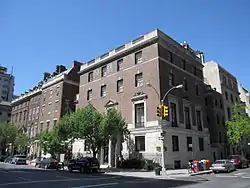Henry P. Davison House
The Henry P. Davison House is a mansion located at 690 Park Avenue and 69th Street on the Upper East Side of Manhattan, New York City.
Henry P. Davison House | |
 Henry P. Davison House on Park Avenue | |
   | |
| Location | 690 Park Ave, New York, New York |
|---|---|
| Coordinates | 40°46′9″N 73°57′56″W |
| Built | 1916-1917 |
| Architect | Walker & Gillette |
| Architectural style | Neo-Federal, Georgian |
| Part of | Park Avenue Houses (ID80002708[1]) |
| NYCL No. | 707 |
| Significant dates | |
| Designated CP | January 3, 1980 |
| Designated NYCL | November 10, 1970 |
History
It was constructed for the banker Henry P. Davison in 1917 by Walker & Gillette in the Neo-Georgian style.[2]
The home was the site of Davison's daughter Alice's wedding to Artemus Gates in January 1922.[3] It was later leased by Marshall Field as his New York residence.[4] In 1925, Davison's widow sold the house to Anson Wood Burchard. The price was not disclosed at the time, but it had been assessed at $530,000 in 1923.[5] After his death in 1927, it was the home his widow, the former socialite Allene Tew, who married German aristocrat Prince Heinrich, 33rd of Reuss in 1929 and used the home as their New York residence. It was later acquired by Harry Payne Bingham, who lived there with his third wife, Melissa Williams Yuille. Since 1952, the building has been the location of the Consulate General of Italy.[2] In 2001, the official seal of the Italian consulate was stolen directly off the front door of the building.[6]
Landmark status
The House was designated a landmark by the New York City Landmarks Preservation Commission in 1970. It was added to the National Register of Historic Places in 1980.[1]
Architecture
The Davison House is the northern terminus of the group of neo-Federal townhouses along the west side of Park, including the Percy R. Pyne House at 680 Park Avenue (today the home of the Americas Society) and the Oliver D. Filley House at 684 Park Avenue (now the Queen Sofía Spanish Institute). In 1970, the New York City Landmarks Preservation Commission wrote:[2]
"Like the other houses in the block, this house has a rusticated limestone first story. The red brickwork above is, like that of its neighbors, laid in Flemish bond and its cornice carefully aligned with theirs. The details of its stonework, however, and most particularly, the elaboration of Its main entrance doorway, give it special distinction.
The elaborate central entrance on Park Avenue is flanked by tow windows in the rusticated stone base. The second floor has three handsomely framed floor length casement windows. The third and fourth floors have four conventional height double-hung windows; those at the third floor are capped by flat arches of brick with stone keystones.
The main entrance is flanked by a pair of freestanding Ionic columns, each with Its own block entablature connected above by a segmental-arch pediment with broken lower chord. The doorway itself, reminiscent of Georgian prototypes, is set in a molded stone archway crowned by a large double keystone. It enframes a pair of heavy wood doors painted black and surmounted by an arched glass fanlight.
Rising directly from the top of the rusticated base, the high second-floor casement windows have elaborately detailed stone enframements. The center window is pedimented with supporting scrolls at either side. The cornices of the flanking windows are crowned by unusual bronze motifs consisting of sphinxes guarding a central urn.
A limestone band-course separates the fourth story from the floors below and incorporates the fourth floor window sit Is. A simple cornice, with balustered parapet above, is the crowning feature of the façade. An attic story, with low copper roof, is hidden behind the parapet.
The 69th Street end of this house corresponds, architecturally, to the main front on Park Avenue. To the south of the main front on Park Avenue, a one storied garage interrupts the limestone base with a pair of wide wood doors painted black. The wrought Iron fence, that runs along the Park Avenue side, emphasizes the entrance to the garage with an exceptionally fine lantern supported at the top of a wrought iron archway."[2]
References
- "National Register Information System". National Register of Historic Places. National Park Service. July 9, 2010.
- "CONSULATE GENERAL OF ITALY (formerly the Henry P. Davison House)" (PDF). s-media.nyc.gov. Landmarks Preservation Committee. November 10, 1970. Retrieved 29 June 2023.
- "MISS ALICE DAVISON TO WED WAR FLIER; Banker's Daughter Is Engaged to Artemus L. Gates, Former Yale Football Star.HER BROTHER'S CLASSMATE Bride-Elect Qualified as an Operatorand Formed Women's Radio Unit in 1916". The New York Times. 9 August 1921. Retrieved 29 June 2023.
- "ADMIRAL BEATTY GETS OVATION IN THEATRE; Audience Applauds When He Is Recognized in Box--Takes a Trip to Wall Street". The New York Times. 23 October 1921. Retrieved 29 June 2023.
- "Mrs. Henry P. Davison Sells Park Av. Home To A.W. Burchard; Assessed at $530,000" (PDF). The New York Times. 17 July 1925. Retrieved 15 November 2019.
- Piano, Carlo (7 September 2001). "Metro Briefing | New York: Manhattan: Theft At Italian Consulate". The New York Times. Retrieved 29 June 2023.
External links
 Media related to Henry P. Davison House at Wikimedia Commons
Media related to Henry P. Davison House at Wikimedia Commons